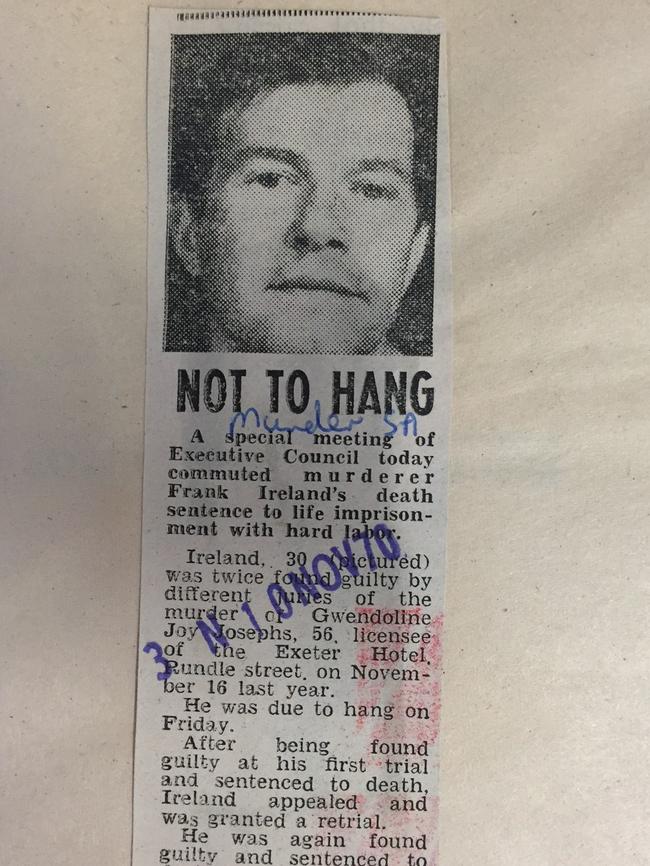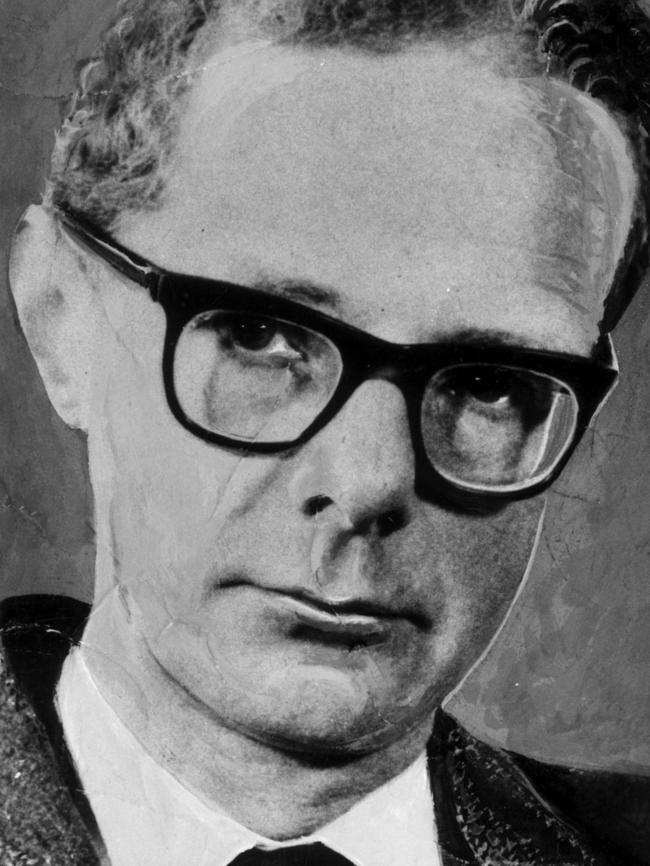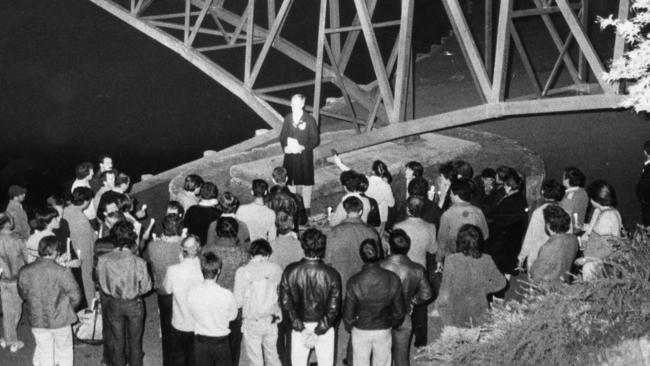Looking back at true crimes that shook our city in the 1900s
ADELAIDE may be known as the city of churches but its deep, dark reputation as the murder capital of Australia spans hundreds of gruesome years. Here are some of the worst cases.

City
Don't miss out on the headlines from City. Followed categories will be added to My News.
ADELAIDE may be known as the city of churches but its deep, dark reputation as the murder capital of Australia spans more than one hundred gruesome years.
From jealous wives to hate crimes, The City reporter Stephanie Timotheou looks at some of the most horrific acts that sprawled across newspaper headlines in the 1900s.
AXE TRAGEDY, 1906
JEALOUSY can tear relationships into shreds but for Ada Hassett – a mentally unstable, foul-mouthed woman – it led to the murder of her husband, John.
The couple had a love-hate relationship (mostly hate) which escalated after she found him in bed with another woman.
The year was 1906 and the pair was residing at The Golden Rule Hotel on the corner of Pirie St and Moger Lane.
Their occasional fights turned into daily arguments and on August 3, Mrs Hassett decided enough was enough and got physical.
The hotel licensee – who could hear everything that went on in their room – phoned the nearby police station asking for urgent assistance.
Constable Stuart was first on the scene and found Mr Hassett lying on a bed with his face covered in blood.
Sitting beside him was Mrs Hassett, staring at her husband’s body without batting an eyelid.
When Constable Stuart asked Mrs Hassett what happened, she replied: “I did it with an axe … it’s in the shed at the back”.
Mr Hassett was still alive and was rushed to the Royal Adelaide Hospital while Mrs Hassett was arrested.
According to historian and researcher Allen Tiller, it was determined that Mrs Hassett entered the bedroom while Mr Hassett was asleep and began to strike him with an axe.
“When she had finished unloading her fury, she calmly returned the axe to the shed at the back of the premises,” Mr Tiller says.
During the trial it was established that there were 19 convictions against Mrs Hassett for drunkenness, seven for using indecent language, four for wilful damage, one for loitering, one for riotous behaviour, one for attempting to commit suicide and one for assault. An article published in The Register (August 6, 1906) stated Mr Hassett’s condition in hospital remained serious but police hung around in case he regained consciousness so they could obtain a statement. He died two days later.
Mrs Hassett was found guilty with a verdict of insanity and was taken to Adelaide Gaol.
MURDER SUICIDE, 1925

IN 1925 King William St was the main shopping strip of Adelaide, bustling with butchers, barbers, eateries and music stores.
At the southern end, near the Crown and Sceptre Hotel, stood Messenger’s Ham Shop – an establishment that served food, but had an upstairs area where people from all walks of life boarded.
One of them was Tom Watson, who had come to Adelaide after living in Melbourne and Sydney.
Not long after he arrived, Mr Watson struck up a relationship with Merle Shelton – a beautiful, 21-year-old, married woman who worked downstairs as a waitress.
On July 14, Ms Shelton arrived just before her shift and headed for the boarding house upstairs. She never returned.
Mr Tiller says the owner of Messenger’s Ham Shop decided to venture upstairs to see where Ms Shelton was – and why she was so late for her shift, despite arriving with plenty of time to spare.
It was there he made the grim discovery. Mr Watson was found in his room, bleeding from two gun shot wounds in his head.
In his hand was a small revolver and lying to the left of him, face down in a pool of blood, was Ms Shelton.
Surprisingly, Mr Watson was still alive and was taken to the Royal Adelaide Hospital, but died shortly after.
The words “Waitress murdered; Boarder commits suicide; End of an unhappy love affair” appeared in The Register (July 15, 1925) the following day, suggesting Ms Shelton was having an affair with Mr Watson and tried to end their lustful relationship which took a turn for the worst.
KITCHEN STABBING, 1969

THOSE who frequent the Exeter Hotel on Rundle St may not look at it the same after discovering its spinechilling past.
In the ’60s a quiet, widowed woman by the name of Gwendolene Joy Josephs ran the hotel and lived there in a room towards the back of the building.
She kept to herself and was described by regular hotel visitors as “someone you’d introduce to your family”.
But on November 18, the 55-year-old’s body was found on the blood-splattered kitchen floor with 10 stab wounds – three in her back and seven all over her body including her arms, hands, stomach and chest.
According to The Advertiser (August 10, 1970) the woman was “cruelly and brutally” murdered by someone who knew her well.
It was later discovered that 30-year-old Frank Ireland, an Englishman who had been living in Adelaide for five-and-a-half years, was her murderer.
Despite pleading innocent throughout the entire trial, Mr Ireland was sentenced to death on March 26, 1970.
When first questioned, he denied being anywhere near the hotel on the night of Ms Josephs’ murder but later changed his story and said he was there.
He claimed he found Ms Josephs in the kitchen alive, turned her onto her side and left her in the dark with the doors closed.
He added that he went home and didn’t call for help because he thought nobody would believe him.
RIVER TORRENS DROWNING, 1972
HOMOSEXUALITY was illegal in 1972 and those who had same-sex relationships would risk paying the price if they were in the wrong place at the wrong time.
This was the case for Adelaide University law lecturer Dr George Duncan who frequented the River Torrens with his partner Roger James to escape reality and spend time together.
The quiet, picturesque area was known by locals as the Number One Beat used by gay men.
Around 11pm on May 10, the couple was approached by a group of men who threw them from the southern bank near Kintore Ave and into the river.
Dr Duncan couldn’t keep himself afloat and drowned, while Mr James managed to get himself out of the river and onto a nearby road.
With a broken ankle, he dragged himself toward traffic and was assisted by a driver who was passing by – convicted child murderer Bevan Spencer Von Einem.
Mr Von Einem took Mr James to the Royal Adelaide Hospital and raised the alarm about the attack.

Fourteen years after the incident, former Vice Squad officers Brian Hudson, Francis Cawley and Michael Clayton were charged with Dr Duncan’s murder.
According to Mr Tiller, witnesses claimed the detectives were accompanied by a tall civilian who was never identified.
Mr Cawley and Mr Clayton eventually went to trial in 1988 but were both freed from the charges after refusing to testify.
During the trial it was alleged that it was common practice for Vice Squad officers to throw homosexuals into the river, certain members assaulted homosexuals and on one occasion, they had even chased an individual while firing shots.
The murder changed SA forever, bringing about a law reform that led to SA becoming the first Australian state to decriminalise homosexuality.
To this day the crime remains unsolved and according to the Crime Stoppers SA website, a reward of $200,000 will be given to those who come forward with information that will help crack the case.

MORE CREEPY MURDERS:
Inspector Richard Pettinger murder, 1862
AT 4.30pm on a Tuesday afternoon in February, Inspector Richard Pettinger was shot dead in the ballroom lobby of Government House where he was in charge of security. The man charged with his murder was ex-police officer John Seaver, who had been dismissed by Pettinger for drunkenness and neglect of duty. According to The News (February 14, 1942), Mr Seaver followed Inspector Pettinger from room to room as the auctions took place. When he finally got his chance, Mr Seaver shot him in the head with a pistol that was concealed under his arm with a black cloth. He was hanged at Adelaide Gaol on March 11.
Tommy Ah Fook murder, 1883
CHINESE chef Mah Poo shot his boss Tommy Ah Fook in the head and dragged his body into a Hindley St cesspit. His body was found four days later by night-workers. Mr Poo was convicted and sentenced to death on October 13 and hanged at Adelaide Gaol on November 10. According to The South Australian Register (November 12, 1883) Mr Poo revealed that Mr Ah Fook always cursed at him and found faults with everything he did in the kitchen. He was the 40th person to be executed in SA.
Murder and attempted suicide, 1910
A GRISLY tragedy unfolded at Curran’s Boarding House (143 Hindley St) which resulted in the murder of 24-year-old Annie Elizabeth Hines and attempted suicide of her husband, Arthur Hines, aged 40. Mrs Hines was found lying in the stairway with her throat slashed from ear to ear. Inside the room, police found Mr Hines lying on the floor with a slit throat. According to The Advertiser (October 5, 1910), three months before the murder, Mr Hines threatened to “blow his wife’s brains out” and on other occasions, Mrs Hines said she feared he would cut her throat in her sleep because he kept a razor under his pillow.
William Halse murder, 1941
FIFTEEN-year-old Brian John Turner was sentenced to life in prison for the murder of bootmaker William Thomas Halse. On May 2, Mr Halse was at his shop on the corner of O’Connell and Marian streets in North Adelaide and never returned home. According to paranormal investigator Allen Tiller, a police officer and Mr Halse’s son went to the premises and found the back door wide open, but the lights turned off at the power board. Near the door they discovered a pool of blood that trailed across the garden and into a shed at the rear of the property. The men entered cautiously and found the 77-year-old man. His skull was broken into pieces, he had cuts across his face and jaw and one of his eyes were severely damaged. In court it was uncovered that Mr Turner did it because Mr Halse told him “Hitler was a good fellow and we had no chance of winning the war”.
Triple murder, 1942
ON December 12, the battered bodies of Horace Lavin Heysed and Alan Gordon Davies were found by firemen in an isolated Hindley St building – now the site of herbal vaporiser store Vaporama – that was set alight. Edward Pate, a 62-year-old man, was also found with severe injuries, but later died at the Royal Adelaide Hospital. According to The Barrier Miner (December 31, 1942), it is believed serial killer George Bray, who had 12 convictions and used many aliases, murdered the three men with an axe.


